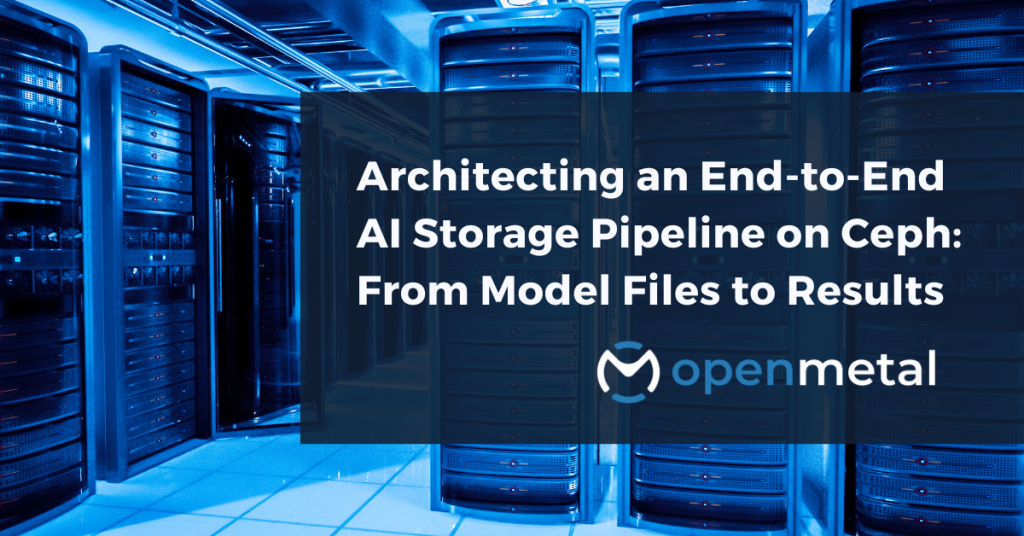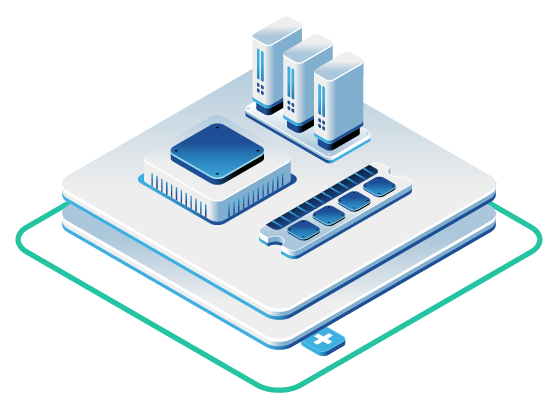
Looking to explore OpenMetal private dedicated storage options?
The OpenMetal team is standing by to assist you with scoping out an infrastructure plan that fits your needs, budgets and timelines.
Organizations building AI infrastructure need storage systems that can seamlessly handle massive training datasets, model files, and results while scaling from pilot projects to production deployments. OpenMetal’s on-demand private cloud with integrated Ceph storage delivers a unified platform that eliminates storage bottlenecks, reduces costs by up to 50%, and scales from 0.5 PB to multi-petabyte environments without downtime—as demonstrated by real customer deployments.
Advanced manufacturing and digital content production companies face a fundamental challenge: their AI initiatives generate exponentially growing data volumes that traditional storage systems simply cannot handle efficiently. Training datasets can span terabytes, model files reach gigabytes in size, and inference results flood storage systems with continuous writes (1). Without proper storage architecture, these workflows hit bottlenecks that turn expensive GPU resources into idle assets waiting for data.
The solution lies in architecting an end-to-end AI storage pipeline that treats data as a strategic asset, not an afterthought. Organizations need infrastructure that can ingest raw datasets, serve training workloads at scale, store model artifacts reliably, and deliver inference results with consistent performance—all while maintaining the security and control requirements of enterprise environments.
Why Private Cloud Infrastructure Transforms AI Storage Economics
Traditional approaches force organizations into complex trade-offs between cost, control, and compliance. While public cloud inference can appear cost-effective for initial experimentation, enterprise-scale AI deployments face significant economic and governance challenges that make private cloud infrastructure increasingly attractive for comprehensive AI strategies.
Hidden Economics of Public Cloud AI: Recent industry analysis reveals that AI inference costs on public cloud platforms are creating sustainability concerns for organizations (5). Unlike training, which is a one-time investment, inference represents a recurring operational cost, making it a critical constraint on AI commercialization (5). AI training is expensive, with a single LLM like GPT-4 consuming over 10,000 GPU hours, while inferencing adds recurring costs, making AI an ongoing financial commitment (6).
Public cloud AI costs escalate through multiple vectors: specialized hardware costs where a single A100 GPU instance can cost over 15X more than a standard CPU instance on Google Cloud (6), unpredictable usage-based pricing models, and cross-regional data transfer fees that can reach $0.09/GB on AWS (6). Organizations report that average monthly AI budgets are set to rise by 36% in 2025 (6), while many companies are turning to colocation and specialized hosting providers rather than the big public cloud operators due to cost sustainability concerns (5).
Data Sovereignty and Control Imperatives: Beyond economics, enterprises face critical governance challenges with public cloud AI deployments. More than half of all AI workloads already reside in a combination of private cloud and on-premises environments, driven primarily by enhanced security (56%), compliance and regulatory demands (51%) (7). The growing complexity of data sovereignty laws—with 62 countries imposing 144 restrictions by 2021, more than doubling from 35 countries in 2017—creates legal compliance challenges that public cloud architectures struggle to address comprehensively (8).
OpenMetal’s Economic and Governance Advantages: OpenMetal’s on-demand private cloud eliminates these compromises by delivering cloud-like agility on dedicated hardware with transparent, predictable pricing and complete data sovereignty. The platform includes unmetered private traffic, meaning data movement between storage and AI workloads costs nothing beyond the base infrastructure—eliminating the surprise billing that plagues public cloud AI deployments. More importantly, OpenMetal’s Ceph integration comes pre-configured and production-ready from day one, enabling organizations to deploy complete private clouds with enterprise-grade storage in under 60 seconds while maintaining full control over data governance and regulatory compliance.
Integrating Ceph Storage into OpenMetal’s Private Cloud Architecture
OpenMetal’s “Cloud Core” deployment model represents a fundamental shift in how organizations approach AI infrastructure. Rather than cobbling together separate compute and storage systems, every OpenMetal private cloud includes a hyper-converged three-node foundation running both OpenStack control services and Ceph distributed storage using battle-tested automation through Kolla-Ansible and Ceph-Ansible.
This integration delivers immediate benefits for AI workloads. The unified platform provides object storage through RADOS Gateway for dataset ingestion, block storage via RADOS Block Device for high-performance training workloads, and file storage through CephFS for shared access patterns—all from a single, self-healing storage cluster (2). Ceph’s efficient storage and management capabilities make it an ideal choice for storing and processing the large datasets required by ML and AI models, while its distributed architecture and parallel processing capabilities help accelerate data analysis tasks (3).
Advanced Performance Architecture: OpenMetal’s Storage Large V3 servers—the most popular configuration for AI workloads—feature dual 32-core/64-thread Intel Xeon Silver 4314 processors (2.4/3.4GHz) with 256GB RAM, providing the computational power needed for Ceph’s erasure coding operations that maximize disk space while maintaining redundancy (4). The hybrid storage design combines 4 x 4TB NVMe drives with 12 x 18TB HDDs, where NVMe drives cache reads and writes above the spinning media, dramatically improving I/O performance for AI workloads that require rapid access to training data (4).
The technical architecture eliminates common pain points. Ceph’s CRUSH algorithm deterministically places data across the cluster without central lookup tables, enabling linear performance scaling as storage nodes are added (2). OpenMetal’s dual 10 Gbps NICs per server (20 Gbps aggregate) provide dedicated pathways for client traffic and cluster replication, ensuring AI workloads never compete with internal storage operations for bandwidth.
Advanced networking capabilities further enhance AI performance. OpenMetal’s VXLAN-ready VLANs enable Layer 2 isolation for predictable performance, while unmetered private traffic supports distributed training scenarios where model synchronization and dataset replication generate massive east-west traffic flows. Built-in DDoS protection secures public-facing inference endpoints without impacting internal network performance.
Architecting Storage Clusters for AI Model Files, Training Data, and Results
AI workloads demand diverse storage patterns that traditional systems struggle to accommodate efficiently. Raw training datasets require massive parallel reads, model checkpoints need consistent write performance, and inference results demand low-latency access with geographic distribution. OpenMetal’s Ceph integration addresses each requirement through purpose-built storage strategies.
Object Storage for Dataset Management: OpenMetal’s RADOS Gateway provides S3-compatible object storage optimized for AI dataset ingestion and management. Organizations can upload massive image corpora, sensor data, or document collections to Ceph buckets and have thousands of training workers access data in parallel. The system automatically distributes objects across the cluster for maximum throughput while maintaining strong consistency guarantees.
High-Performance Block Storage: AI training workloads attach Ceph RBD volumes that deliver NVMe-class performance through OpenMetal’s all-flash configurations. GPU nodes can sustain continuous data feeds without waiting for storage, maximizing expensive compute resource utilization. Block volumes support live migration, snapshots, and cloning—enabling rapid experiment iteration and rollback capabilities.
Shared File Systems: CephFS provides POSIX-compliant distributed file storage for collaborative AI development. Multiple researchers can access shared datasets simultaneously, while distributed training frameworks can coordinate through shared file systems without complex data replication schemes. The system maintains file-level consistency across the cluster while delivering parallel access performance.
The unified architecture eliminates data silos and reduces operational complexity. Instead of managing separate systems for different data types, AI teams work with a single storage platform that automatically handles replication, consistency, and performance optimization across all workload types.
Horizontal Scaling and Redundancy Strategies for Growing AI Workloads
OpenMetal’s Ceph clusters demonstrate proven scalability in production environments. The MyMiniFactory deployment (below) showcases real-world growth from 0.5 PB to 1.9 PB raw capacity in under a year through simple node additions. Ceph’s architecture enables this seamless scaling by automatically redistributing data using the CRUSH algorithm without downtime or performance degradation.
Flexible Redundancy Options: OpenMetal configures Ceph with intelligent redundancy strategies tailored to AI workload requirements. The default three-node replication provides immediate fault tolerance—organizations can lose two of three nodes while maintaining full data access (2). However, OpenMetal’s approach recognizes that data center-grade SSD and NVMe drives with 2 million hour MTBF (6x better than traditional HDDs’ 300,000 hours) enable more efficient replica strategies (4).
For capacity optimization, OpenMetal often recommends replica 2 configurations that provide significant usable space advantages: a standard cluster with replica 2 delivers 4.8TB usable compared to 3.2TB with replica 3, representing 50% more available storage (4). When combined with erasure coding for large datasets, organizations achieve remarkable efficiency: 2/1 coding delivers 66.67% efficiency, 8/3 coding achieves 72.73% efficiency, and advanced 17/3 coding reaches 85% efficiency (4).
Self-Healing Infrastructure: Ceph’s automated recovery capabilities eliminate the operational burden of managing storage failures (9). When drives fail or nodes experience issues, the cluster automatically detects problems and re-replicates data to healthy nodes. With replica 2 configurations, Ceph can self-heal by automatically copying any data that falls to single replica status back to the target replica level, ensuring continuous protection during the recovery process (4).
Performance Scaling with Predictable Economics: Adding storage nodes increases both capacity and aggregate throughput with transparent, predictable costs. OpenMetal’s storage clusters scale from 330 TiB at $0.00940/GiB to 2,810 TiB at $0.00738/GiB, demonstrating clear cost advantages at scale (4). Unlike public cloud providers with complex pricing tiers, OpenMetal’s approach includes substantial egress bandwidth allowances—from 36TB monthly for smaller clusters to 240TB for enterprise deployments—with transparent additional egress pricing at $0.37 per Mbit per week via 95th percentile billing (4).
Strategic scaling approaches maximize investment efficiency. Organizations typically start with the three-node Cloud Core for development and testing, then add dedicated storage nodes as production workloads grow. This approach avoids over-provisioning while ensuring the infrastructure can adapt to changing requirements.
Real-World Success: MyMiniFactory’s Scalable Content Platform
MyMiniFactory’s transformation illustrates how OpenMetal’s Ceph-based infrastructure addresses real-world AI and digital content challenges. As a leading 3D printing platform, MyMiniFactory manages massive repositories of user-generated content files while delivering consistent global access performance.
The Challenge: Managing exponential content growth while maintaining user experience quality and controlling infrastructure costs. Traditional storage systems created bottlenecks during peak usage periods, while public cloud costs escalated unpredictably with data growth.
OpenMetal’s Solution: A hosted Ceph storage cluster starting with 0.5 PB raw capacity across three dedicated storage nodes, each equipped with 12×12 TB drives. The implementation used OpenMetal’s Standard Cloud Core for control plane services with seamless integration to dedicated storage infrastructure.
Scaling Success with Erasure Coding Optimization: Within 12 months, the cluster expanded to 9 storage nodes with 12×18 TB drives each, reaching approximately 1.9 PB total capacity. The transition to erasure coding (7/2 scheme) maximized space efficiency while maintaining fault tolerance, demonstrating the flexible redundancy strategies that OpenMetal’s Ceph implementation enables. Performance remained consistent throughout the scaling process, showcasing Ceph’s ability to grow without degradation while leveraging OpenMetal’s NVMe caching architecture for sustained I/O performance.
Quantifiable Benefits:
- High Availability: Fault-tolerant architecture eliminated service interruptions during maintenance and hardware failures
- Rapid Scaling: Adding capacity required no downtime or complex data migrations
- Cost Optimization: Achieved better cost per terabyte while dramatically improving performance
- Halved Infrastructure Costs: Total cloud expenses decreased approximately 50% compared to previous solutions
The MyMiniFactory case demonstrates how storage-intensive platforms can achieve enterprise-grade reliability while controlling costs through OpenMetal’s managed private cloud approach.
OpenMetal’s Competitive Advantages for AI Storage Deployments
Rapid Deployment and Global Reach: OpenMetal’s storage clusters deploy in approximately 48 hours for standard configurations, enabling organizations to move from planning to production AI workloads faster than traditional procurement cycles (4). The platform operates from strategically located Tier III data centers in the United States (2), Netherlands (1), and Singapore (1), positioned near high concentrations of IT, telecommunications, biotechnology, federal government, and international organizations (3). All facilities maintain ISO 27001 certification for enhanced data security and privacy, with multiple layers of redundancy supporting compliance with various federal regulations and industry standards (3).
24/7 Engineer-Led Support: OpenMetal’s support model goes beyond traditional ticket handling to provide architectural guidance and technical collaboration. The engineering team actively monitors Ceph clusters and provides proactive optimization recommendations. This approach ensures AI teams can focus on model development rather than infrastructure troubleshooting.
Purpose-Built Hardware Performance: OpenMetal’s Storage Large V3 servers deliver dedicated bare metal performance optimized for AI workloads. The hybrid storage architecture with NVMe caching provides dramatic I/O improvements over traditional spinning media, while powerful dual 32-core processors handle Ceph’s computational requirements for erasure coding and data management operations (4). Single-tenant infrastructure ensures consistent performance without noisy neighbor effects that can impact AI training schedules.
Advanced Networking with Cost Control: High-performance private networking with 20 Gbps connectivity per server supports bandwidth-intensive AI operations, while the fair egress pricing model with transparent 95th percentile billing provides cost predictability for data-heavy workloads (4). The unmetered private traffic capability enables distributed training scenarios and data replication without additional charges.
Strategic Implementation for Enterprise AI Success
Organizations should approach AI storage architecture as a strategic investment that balances the cost-effectiveness of public cloud for certain workloads with the control and security of private infrastructure for sensitive operations. While public cloud inference can offer advantages for experimentation and non-sensitive workloads, the combination of escalating costs, data sovereignty requirements, and governance needs makes hybrid approaches the optimal long-term strategy.
The Nuanced Economics of AI Deployment: Research shows that inference costs vary significantly based on workload type and scale. For small-scale or experimental AI deployments, public cloud pay-as-you-go models provide accessibility without upfront investment. However, at enterprise scale, the economics shift dramatically. Organizations running large-scale AI workloads report cost reductions of 50-67% by moving to private cloud infrastructure, particularly for consistent, predictable workloads where the recurring nature of inference costs makes dedicated infrastructure more economical.
Data Sovereignty as a Strategic Imperative: The growing emphasis on data sovereignty reflects more than regulatory compliance—it represents fundamental questions of control, security, and competitive advantage. Organizations in regulated industries like healthcare, finance, and government face explicit data localization requirements, while global enterprises must navigate complex cross-border data transfer regulations that create operational and legal risks with public cloud deployments.
OpenMetal’s Hybrid-Ready Platform: OpenMetal’s approach enables organizations to implement sophisticated hybrid strategies that leverage the best of both worlds. Development and experimentation can occur using public cloud resources for rapid iteration, while production workloads, sensitive data processing, and mission-critical AI applications run on OpenMetal’s private cloud infrastructure with integrated Ceph storage.
Strategic Implementation with Predictable Economics: Organizations typically begin with OpenMetal’s 330 TiB starter clusters at $3,175.20/month ($0.00940/GiB), which deploy in approximately 48 hours and provide immediate production capability for AI development teams (21). As workloads scale, the platform enables seamless growth to 1,325 TiB power clusters ($11,642.40/month, $0.00858/GiB) or enterprise-scale 2,810 TiB configurations ($21,168.00/month, $0.00738/GiB), demonstrating clear cost advantages as data volumes increase (21).
Global Deployment Flexibility: OpenMetal’s strategic data center locations across the United States, Netherlands, and Singapore enable organizations to implement data sovereignty strategies while maintaining performance and compliance requirements (21). All facilities maintain ISO 27001 certification and support various federal regulations, addressing the governance concerns that drive private cloud adoption for AI workloads.
Conclusion: Building the Foundation for AI-Driven Innovation
The convergence of artificial intelligence and distributed storage has reached a critical inflection point where storage architecture directly impacts AI initiative success. Organizations can no longer treat storage as an afterthought—it must be architected as a strategic enabler that accelerates innovation rather than constraining it.
OpenMetal’s private cloud platform with integrated Ceph storage provides a compelling foundation for enterprise AI initiatives. The combination of cloud-like agility, enterprise-grade reliability, and predictable costs creates an environment where AI teams can focus on advancing business objectives rather than managing infrastructure complexity.
The MyMiniFactory case study demonstrates quantifiable benefits: halved infrastructure costs, seamless scaling from 0.5 PB to 1.9 PB, and consistent performance throughout exponential growth. These results reflect the broader value proposition of purpose-built AI infrastructure that treats data as a strategic asset.
Organizations building AI capabilities today need infrastructure that can adapt to uncertain future requirements while delivering immediate value. OpenMetal’s platform provides this flexibility through proven technology, transparent pricing, and expert support that transforms storage from a bottleneck into a competitive advantage.
The strategic choice is clear: while public cloud offers valuable capabilities for AI experimentation and specific use cases, organizations building comprehensive AI capabilities need infrastructure that balances cost-effectiveness with control, compliance, and security. OpenMetal’s private cloud platform with Ceph storage provides the foundation for hybrid AI strategies that leverage the strengths of both deployment models while maintaining data sovereignty and predictable economics for sustainable AI-driven innovation.
Ready to find out more? Our team is standing by.
Works Cited
- IBM. “Infrastructure for AI: Why Storage Matters.” IBM Think Insights, 2024, https://www.ibm.com/think/insights/infrastructure-for-ai-why-storage-matters. Accessed 13 Aug. 2025.
- Ceph Development Team. “Ceph: A Scalable Distributed Storage System.” Ceph.io, 2024, https://ceph.io/en/discover/. Accessed 13 Aug. 2025.
- OpenMetal. “Large Scale Object Storage Clusters, S3 Compatible Ceph.” OpenMetal Products, https://openmetal.io/products/storage-clusters/. Accessed 13 Aug. 2025.
- OpenMetal. “Storage Cluster Pricing.” OpenMetal Pricing, https://openmetal.io/storage-cluster-pricing/. Accessed 13 Aug. 2025.
- The Register. “AI adoption stalls as inferencing costs confound cloud users.” The Register, 13 June 2025, https://www.theregister.com/2025/06/13/cloud_costs_ai_inferencing/. Accessed 13 Aug. 2025.
- CloudZero. “The State Of AI Costs In 2025.” CloudZero Blog, Aug. 2025, https://www.cloudzero.com/state-of-ai-costs/. Accessed 13 Aug. 2025.
- GTT Communications. “GTT Study: Private Cloud Adoption Accelerates as Enterprises Prioritize Security, Compliance — and Now AI.” GTT Press Release, 2024, https://www.gtt.net/gb-en/about-us/press-releases/gtt-study-private-cloud-adoption-accelerates-as-enterprises-prioritize-security-compliance-and-now-ai/. Accessed 13 Aug. 2025.
- ISACA. “Cloud Data Sovereignty Governance and Risk Implications of Cross Border Cloud Storage.” ISACA Industry News, 2024, https://www.isaca.org/resources/news-and-trends/industry-news/2024/cloud-data-sovereignty-governance-and-risk-implications-of-cross-border-cloud-storage. Accessed 13 Aug. 2025.
- SUSE. “SES 7 | Deployment Guide | SES and Ceph.” SUSE Documentation, https://documentation.suse.com/ses/7/html/ses-all/cha-storage-about.html. Accessed 13 Aug. 2025.
- TechResearchs. “The Best Cloud AI Services in 2025: A Comprehensive Guide.” TechResearchs, 13 Feb. 2025, https://techresearchs.com/artificial-intelligence/the-best-cloud-ai-services-in-2025-a-comprehensive-guide/. Accessed 13 Aug. 2025.
- Equinix. “Data Sovereignty and AI: Why You Need Distributed Infrastructure.” Interconnections Blog, 15 May 2025, https://blog.equinix.com/blog/2025/05/14/data-sovereignty-and-ai-why-you-need-distributed-infrastructure/. Accessed 13 Aug. 2025.
- CIO Magazine. “Private cloud makes its comeback, thanks to AI.” CIO, 30 May 2025, https://www.cio.com/article/2104613/private-cloud-makes-its-comeback-thanks-to-ai.html. Accessed 13 Aug. 2025.


































